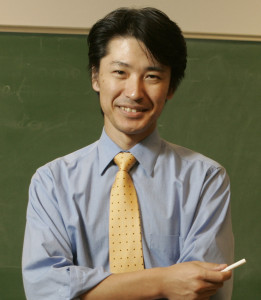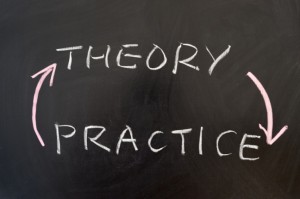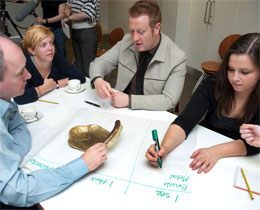Theoretically and epistemologically, my alignments have, perhaps, not changed drastically over the past six years I have been a teacher; however, the more I learn and study, the better I am able to articulate what these theories are and to put them into practice as a teacher at a community college more explicitly and consciously. I’d like to examine my theoretical perspective, both as a researcher and a teacher, in a linear process in which I move through things I have learned in both my MA and PhD programs, and how they have informed my scholarship and teaching.
Feminist theory has been something that has long been part of my personal and professional philosophy of teaching, learning, and research. I first read Judith Butler as an undergraduate, but went back again and again to her Gender Trouble in graduate school. In this text, she posits that only cultural meaning assigns us as a “woman” or a “man” (xiv). Butler argues that the reason we have two ‘typical’ genders is because our categories of sex are established through a process called “performativity,” which means that the norms of sex and identity are substantiated and made “normal” by being repeated, and are therefore eventually considered ideal (xv). This was a fairly revolutionary idea to me at the time, but these ideas have become a large part of my scholarship, particularly in literature. I have used Butler and other feminist writers to make entry way into Shakespeare, Mark Twain, and other authors. It is something I find myself coming back to again and again. Often, even when I attempt to write a paper using a different lens, I still end up moving back towards a feminist critique. In more recent years, particularly now that I am a teacher, I find myself relying more heavily on Judith Lorber, who has a similar stance to Butler in arguing that gender is not a fixed category but is culturally assigned, but she goes into greater depth in discussing how gender, as a “modern social institution is [meant] to construct women as a group to be the subordinates of men as a group” (62). She essentially argues that inequality in the world comes from the creation and constant re-creation of classifications based on social norms.
[Judith Butler presented a conference in summer 2015 entitled “Why Bodies Matter,” in which she discussed the 25th anniversary of Gender Trouble, her groundbreaking theory on how gender is created and re-created through cultural means. This book has been shifting my worldview, my research, and my pedagogy for the past ten years.]
The arguments by both authors have again and again changed not only the way I view the world and view texts in the world, but they also now inform my teaching. I teach my ENG 111 class as a theme on “identity” in which students examine race, gender, and social theories posited by influential writers in these sub-disciplines. What I find so interesting is that I did not realize that this method of teaching is really a large part of our discipline of English studies until Dr. Phillips came to talk to our class. It was in reading the work she provided for the class, as well as our discussion on how cultural studies falls under the umbrella of English studies that I became aware that what I am teaching, which now goes far beyond feminist and gender theory, is a core of our field. Dr. Phillips mentioned that cultural studies has become part of English studies because, as Figueira said in “Comparative Literature versus World Literature,” English is the center of theory. This explicit knowledge has changed the way I view my subject and has made me reconsider other ways that I might incorporate a greater focus on cultural studies in my classroom. What I thought I was doing was making my students more aware learners about their world. I see now it goes beyond that and is a core part of learning in the English field.

Paul Kei Matsuda has easily been one of the greatest influences on both my pedagogy and just on me as a person on an individual level.
In addition to a feminist and cultural studies alignment, I was also greatly influenced during graduate school by CCCC’s “Students’ Right To Their Own Language” and Paul Kei Matsuda’s theories of student language use in the classroom. Not only has this become a large part of my scholarship for this class, as it is evident in nearly all of my papers, but it also informs my teaching, particularly as a teacher of developmental English. The C’s resolution argues that due to the changing face of America, more and more students with linguistic diversity will be entering the classroom with “their own patterns and varieties of language — the dialects of their nurture or whatever dialects in which they find their own identity and style” and that as teachers, we must respect these differences. Kei Matsuda writes nearly thirty years after the C’s resolution to rearticulate a similar idea, the “myth” of linguistic homogeneity, in which teachers see good writing as that which is “unmarked in the eyes of teachers who are the custodians of privileged varieties of English” (640). Kei Matsuda sees this myth as highly unrealistic in higher education institutions of today. One final influence is that of Ana Maria Preto-Bay and Kristine Hansen, who argue that as we reach a “tipping point” of having more linguistically diverse students than students who speak English natively, we must consider strategies for “negotiating the constraints and complexities posed by various audiences, purposes, and situations,” essentially a rhetorical grammar “for serving the new student population” (48).
As a developmental teacher, I take C’s and Matsuda’s challenge very seriously. I focus with my students on a rhetorical (rather than a punitive prescriptive) grammar and talk about how we make different linguistic choices for a particular audience or situation. I let my students know that I am more concerned with their thinking than their “perfect” writing and that while I expect careful, thoughtful writing and editing, linguistic differences, such as issues with preposition use, are not necessary for showing their talent for composition. This attitude has made me a developmental teacher that is sought out each semester by students, as they feel the respect and comfort that comes from such a methodology.
Finally, I find that I align myself as both a teacher and a scholar with a developmental theory of learning. This is my most recent area of study, having first encountered these theories in Dr. Phelps’ Practical Theory course in summer 2015. I had not before read Vygotsky, which as you can see from my work for this course, has influenced my thinking about teaching and also my scholarship. Particularly as a teacher of developmental English, I see how the Zone of Proximal Development can help my students to learn. I also am greatly influenced by the work of Janice Hays, who argues that learning is lifelong and that it is not “straightforward and linear” (12-13), but rather students move constantly forward and backward in refining complex thinking and becoming aware of ambiguity in the search for ideas and knowledge (15). She recommends that we must discover where our students are developmentally and teach to them at that level – for example, things that as teachers tend to emphasize, such as considering an outside reader, may not be best for them if they are not yet at a level of development where they can envision that reader (19). She also suggests that we must not make writing tasks beyond what students are ready for, as they will become discouraged and fall back to “safer levels of functioning” (22). These theories are something I incorporate into my own pedagogy as I plan lessons and assignments at a particular level. I know when I give students a challenging reading, for example, we’ll have to spend more time talking and thinking about it. It is also an epistemological alignment that I am very motivated in continuing to study as I move through PhD coursework. I think it is a particularly important theory for community college in which we teach such drastically mixed and low-level students. Considering how we can teach each student as an individual is so crucial.
While today these are my theoretical alignments, this paper topic has made me think: as I work my way through my PhD coursework, will these alignments change, or simply expand? I hope most certainly that they will expand, for in doing so, I can only become a more careful and dedicated teacher. I see myself now primarily as a teacher-researcher; therefore my primary goal is to always be a good teacher, but I feel thankful to have an opportunity to continue to study, to learn, and to expand myself as not only a teacher but a thinker and scholar.
Works Cited
Butler, Judith. Gender Trouble. 1990. New York: Routeledge, 2008. Print.
Conference on College Composition and Communication Committee on Language Policy. “Students’ Right to Their Own Language.” CCC 25.3 (1974) 1-32. Rpt. in Students’ Right to Their Own Language: A Critical Sourcebook. Ed. Staci Perryman-Clark et al. New York: Bedford/St. Martin’s, 2015. 19-57. Print.
Figueira, Dorothy M. “Comparative Literature versus World Literature.” The Comparatist 34 (2010): 29-36. Print.
Hays, Janice N. “Models of Intellectual Development and Writing: A Response to Myra Kogen Et Al.” Journal of Basic Writing 6.1 (1987): 11-27. Print.
Kei Matsuda, Paul. “The Myth of Linguistic Homogeneity in U.S. College Composition.” College English 68.6 (2006): 637-651. Print.
Lorber, Judith. “‘Night To His Day’: The Social Construction of Gender.” Paradoxes of Gender. New Haven: Yale University Press, 1994. Print.
Preto-Bay, Ana Maria and Hansen, Kristine. “Preparing for the Tipping Ponit: Designing Writing Programs to Meet the Needs of the Changing Population.” WPA 30. 1-2 (2006): 37-57. Web.
Vygotsky, Lev. Mind in Society. Cambridge: Harvard University Press, 1978. Print.


